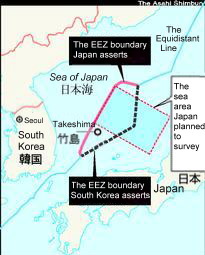 It was begun with an article on a Korean website late in November 2005. The article says that South Korean government intends to register Korean names for submarine features on the seafloor surrounding Takeshima (竹島; called Dokdo 獨島 by the Koreas, currently unlawfully occupied by South Korea) at an upcoming official GEBCO Sub-Committee on Undersea Feature Names[1] sponsored by the International Hydrographic Organization (IHO)[2] conference in Germany (Bremerhaven) in June 2006.
It was begun with an article on a Korean website late in November 2005. The article says that South Korean government intends to register Korean names for submarine features on the seafloor surrounding Takeshima (竹島; called Dokdo 獨島 by the Koreas, currently unlawfully occupied by South Korea) at an upcoming official GEBCO Sub-Committee on Undersea Feature Names[1] sponsored by the International Hydrographic Organization (IHO)[2] conference in Germany (Bremerhaven) in June 2006.
South Korea's plan is to propose names for, indeed, 18 submarine features including six in an area claimed by both Japan and South Korea as their Exclusive Economic Zone (EEZ) in the Sea of Japan (日本海; South Korea does not accept the name and calls it "Donghae" [East Sea] (東海) by the local name). This is South Korea's campaign to fill up the geographical features of the "Sea of Japan" with Korean names in order to accomplish to make the sea as the "Sea of Korea" (Donghae). Japan did not keep silence, and announced a countermeasure against South Korea's plot in the official gazette on April 14, 2006.
The Japanese Government announced in the official gazette on April 14, 2006 about a plan to conduct a hydrographic survey of the seabed in an area around Takeshima by the Japan Coast Guard (海上保安廳, JCG)[3] after an interval of 30 years. Two survey vessels of the Japan Coast Guard, 621t "Meiyō" (明洋) and 605t "Kaiyō" (海洋) arrived in Sakai Minato Harbor (境港), Tottori Prefecture (鳥取縣, southeastern Japan) on April 19 from Tokyo Port awaiting offshore in the Miho Bay (美保灣).
The South Korean government responded quickly to the JCG announcement, with the Blue House saying "the survey would be seen as an infringement of its sovereignty"[*1] and "it would not hesitate to seize the ships [if they intrude into South Korea's EZZ],"[*2] and eventually deployed their fleet of 20 KCG[4] guard ships including a 5,000t guard ship Sambong and a patrol seaplane Challenger to threaten as if "it will be the Battle of Tsushima II (日本海海戰; a sea battle of the Russo-Japanese War of 1904-05)[5] between Korea and Japan in the area around Takeshima!"
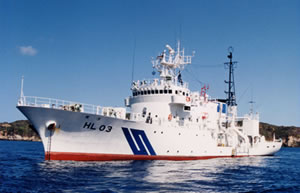 |
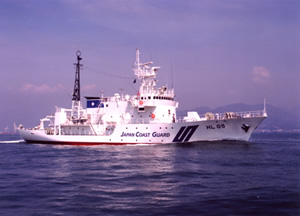 |
| JCG survey vessel "Meiyō" |
JCG survey vessel "Kaiyō" |
Japanese Vice Foreign Minister (Deputy Chief Cabinet Secretary) YACHI Shōtarō (谷内正太郎) met Yu Myong-hwan (柳明桓), South Korea's First Vice Foreign Minister in Seoul on April 21 to have a negotiation. On the next day, this "conflict" was compromised that accord on condition South Korea to retreat the plan to register Korean names for seabed topography at the IHO Conference in June in exchange for Japan to stop the planned survey. The Kaiyô and the Meiyô anchored off Sakai Minato harbor and returned to Tokyo Port. Nevertheless Seoul's hard-line approach sounded perhaps overreacting, the attitude rather exposed Korea's fear, or perhaps, a kind of awe to Japan. So this essay is about the "Korea's shudder" behind the "hydrographic survey slapstick comedy" and the absurd subsequences of the affair.
1. Survey ships break the tranquil sleep of the Sea of Japan
"The head of the national defense answered that he is confident to complete the duty whenever commanded," South Korean President No Mu-hyeon (Roh Moo-hyun 盧武鉉) said at the meeting with leaders of political parties in the evening of April 18. South Korea deployed the KCG 20 guard ships and a patrol seaplane against Japanese survey vessels in the case if they force to conduct a hydrographic survey in Korea's EEZ (that Japan does not accept) including an area around Takeshima, and gave a strong impression to the Korean people that "outbreak of war is approaching." From an objective view, it seems rather overreacting or perhaps eccentric. The Japanese survey is a legitimate act permitted by the United Nations Convention on the Law of the Sea (UNCLOS), Article 238.
|
United Nations Convention on the Law of the Sea (UNCLOS)
Article 238. Right to conduct marine scientific research
All States, irrespective of their geographical location, and competent international organizations have the right to conduct marine scientific research subject to the rights and duties of other States as provided for in this Convention.
|
|
To avoid any unnecessary conflict, only two JCG survey vessels were planned to voyage to the sea area without any accompaniment by patrol ships or JMSDF (海上自衛隊; Japan Maritime Self-Defence Force)[6] escort ships and the crew did not carry any arms. Nevertheless, South Korea deployed 20 gunboats against two "unarmed" survey vessels that are going to do a legitimate survey under the UNCLOS, and menaced to force out or seize them if the survey vessels reach the area. It rather seemed to me overreacting or perhaps eccentric. What made Koreans deploy 20 guard ships against two unarmed survey vessels and their President say "the head of the national defense answered that he is confident to complete the duty whenever commanded?" The question itself is the most substantial of this issue.
There is a famous Japanese Kyôka (狂歌; humorous poem similar to the 5-line Tanka) at the end of the Edo Period (江戸時代, 1603-1867) :
泰平の眠りをさます上喜撰
たった四杯で夜も寝られず
Taihei no nemuri o samasu Jōki-sen,
Tatta shihai de yoru mo nerarezu
Jōki-sen awakes a tranquil world from sleep,
with only four cups, no more sleep at night.
In its hidden meaning, this poem satirizes the arrival of the "Kurofune" fleet (黒船, "Black Ships" that described western iron warships)[7] commanded by Commodore Perry from the U.S. in 1853. This poem is a complex set of puns. Taihei means "tranquil" (泰平) or the "Pacific Ocean" (太平), Jōkisen means a costly brand of green tea containing large amounts of caffeine (Jō-kisen 上喜撰) or "steam-powered ships" (Jōki-sen 蒸氣船), and shihai means "four cups" (四杯) or "four ships" (四隻). The alternate translation based on the pivot words is:
Steamships break the tranquil sleep of the Pacific,
only four ships make us lose sleep at night.
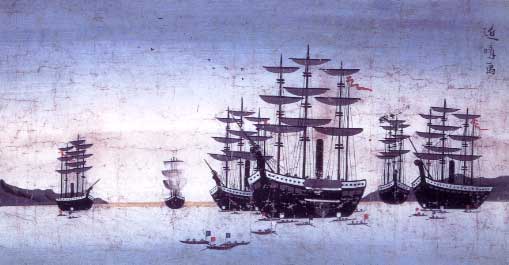
"Landscape of Ushioda in Musashi Province" by Chikaharu
(Kurofune Museum, owned by the Kurofune-kan Foundation, Niigata, Japan)
近春 武州潮田遠景
South Korea's overreaction in the recent "hydrographic survey slapstick comedy" indeed reminds us this famous poem.
The JCG vessels also planned for surveying the area around Takeshima. Although these vessels are unarmed, South Korea was frightened by these governmental vessels, even unarmed, entering into the area around Takeshima for the first time since February 27, 1953 when South Korea invaded and unlawfully occupied Takeshima. South Korea's Maritime Police and the Navy only prepared a manual to cope with private vessels such as Japanese right wing activists approaching and stopping at Takeshima. But it was a totally "unexpected case" that Japan's governmental vessels may approach at Takeshima.
And that was, in fact, they were not prepared how to deal with Japanese governmental survey vessels approaching the sea area around Takeshima. Korean President No Mu-hyeon repeatedly say his public-catching statement "We take strong measures against Japan" in his public speeches to attempt recovering seriously declining public support for the Uri Party. This time, he said that "the head of the national defense will complete the duty [for the emergency case]" although we've heard some rumors that he was actually flurried behind his official face, "what can I do if Japan's survey vessels really come?" and it is said that he had sleepless nights by anxiety.
2. An experiment to finish the Korean Navy off
This time, although Japan's purpose was simply conducting a hydrographic survey, South Korea menaced, "it would not hesitate to seize the ships." Was South Korea able to do for sure? It is an interesting question, but there is only one conclusion — it is absolutely impossible.
As its official English name "Japan Coast Guard" (JCG) suggests, the Japan Maritime Safety Agency (海上保安廳) is a national organization that is responsible for harbor defense, port security and coastal patrols. The definition of "coast guard" is internationally understood as "the branch of a nation's armed forces."[*3] This is why the JCG patrol vessels were capable to have a gunbattle with North Korea's suspicious vessel in 2002 that means these JCG patrol vessels equipped heavy firearms. As long as JCG survey vessels belong to the Coast guard, they are therefore regarded as military ships regardless unarmed (Military ships are not always warships). If coast guard patrol ships are seized or attacked, the naval forces will put in action — this is the international convention. If JCG survey vessels are seized (or abducted) by KCG guard ships, it is regarded that vessels of the naval forces got attacked. The only choice Japan can take is to put the JMSDF in action to defend. And South Korea has to dispatch the Navy in order not to lose face — this is the situation what Seoul was afraid of.
"It will be the 'Battle of Tsushima II' between Korea and Japan!" South Korea seemed warlike as if saying like this. If Japan's Maritime SDF and Korean Navy actually engage in a battle, which country will the Goddess of Victory smile upon? It is an interesting question but it will result in a Japan's overwhelming victory. If Japan and South Korea engage in a total naval war (a decisive battle using all of resources), it only takes some for 10 minutes Korean Navy to be annihilated. If air forces of both countries join the battle, it shortens the time to finish, according to think tanks in Japan and in the US.
The following is an article from a Korean newspaper "Joong Ang Ilbo"(中央日報) on September 27, 2005. The application of Lanchester's N-Squared Law[8] of warfare to the data in the article leads to a more surprising conclusion.
|
The Fighting Power of the Japan Maritime SDF is 3.7 times as strong as the Korean Navy
September 27, 2005 KST 8:13:24AM
by Kim Min-seok
(Specialist in military issues)
Joong Ang Ilbo (South Korea)
The fighting power of the Japan Maritime Self-Defense Forces (JMSDF) has been estimated that it is 3.7 times as strong as the Korean Navy.
According to the data which Korean Navy submitted to Song Young-sun (宋永仙), a Hannara Party (Grand National Party) lawmaker in the National Assembly's Defense Committee, the Korean Navy has 173 warships that quantity is 1.5 times as many as JMSDF but its fighting strength is still inferior because Japan's warships are larger than Korea's and equip stronger arms.
A JMSDF's Kongō class Aegis destroyer has been estimated to be 6.8 times as strong as a Korea's FF class frigate and 2.5 times as a KDX (Korean Destroyer Experimental) class destroyer.
The fighting powers of destroyers and each transports were calculated based on the capabilities of navigation, transport and defense, and submarines based on the capabilities of mobility, search control and offensive power.
|
|
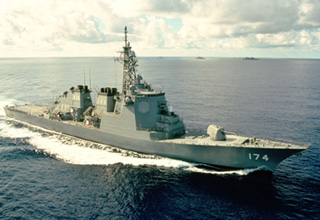 |
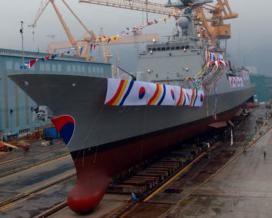 |
JMSDF's Kongō class Aegis destroyer
DDG-174 "Kirishima" (きりしま) |
South Korean Navy's KDX-II class destroyer
"Gang Gamchan" (姜邯賛) |
Here is the application of the Lanchester's N-Squared Law to the data of JMSDF and the Korean Navy:
|
Lanchester's N-Squared Law of Combat
(Second Law)
(Aw × An²) - (Bw × Bn²) = √ D
| Aw |
= |
weapon efficiency of army A troops |
| An |
= |
number of army A troops |
| Bw |
= |
weapon efficiency of army B troops |
| Bn |
= |
number of army B troops |
| √ |
= |
square root |
| D |
= |
disparity in combat strength |
|
|
An experiment on Lanchester's Law to finish the Korean Navy off:
J fighting power 3.7 × number of J troops 114² = 48,085.2
K fighting power 1 × number of K troops 173² = 29,929
The disparity in combat strength is:
48,085.2 – 29,929 = 18,156.2
√ 18,156.2 = 134.744944
Number of J warships 114 – disparity 134 = –20
|
|
The theoretical conclusion is:
The JMSDF is capable to annihilate the Korean Navy's all 173 warships without losing even one warship.
Although if they are aware of the reality and still said "it would not hesitate to seize the ships" and threaten as if "it will be the Battle of Tsushima II!," it seems just like they lost sanity. Well, of course they know. They intentionally repeated excessive reactions to let Japan compromise. They prayed for the God.
3. The absurd subsequences of this comedy show
A Japanese proverb "Once down the throat, the heat is forgotten" exactly represents the subsequent events after the compromise. Only three days after the vice foreign ministers' negotiations on April 22 (it was actually not a fundamental solution), President No Mu-hyeon announced his "special address" to the public on April 25 to add to Japan's irritation.
|
President Roh Moo-hyng gave a special statement on TV
"Physical provocations will be met with strong and firm responses"
April 25, 2006 JST 11:46AM
by HORIYAMA Akiko
Mainichi Shimbun (Japan)
SEOUL — South Korean President No Mu-hyeon announced a "Special Statement on Korea-Japan Relations" Tuesday for the recent conflict between Japan and South Korea concerning with Takeshima (Korean "Dokdo"). President Roh defined the Takeshima dispute as a question of a compensation of the history and criticized that, "Japan's present claim to Dokdo is tantamount to maintaining a right to what it had once occupied during an imperialist war of aggression." He said that "Physical provocations will be met with strong and firm responses" and declared that his government will completely reconsider the "quiet diplomacy" that was the policy to avoid evolving it as a dispute.
It was the first time President Roh to announce a special statement on Japan-Korea relations. It was broadcast live nationwide on TV.
President Roh emphasized the historical significance of Takeshima as "the first territory of Korea to be seized in the course of Japan's usurpation of the Korean Peninsula."
He called the Russo-Japanese War as "a war of aggression over the Korean Peninsula" and described Japan's annexation of Takeshima in 1905 that, "under the pretext of carrying out the war, Japan sent its troops to Korea and occupied the Korean Peninsula."
Roh defined the Takeshima Issue as "a symbol of the complete recovery of sovereignty" and stated to deal with this as an issue of a liquidation of the history including claims to the Yasukuni Shrine and Japanese history textbooks. He emphasized the issue of naming underwater geological formations around Takeshima is "our legitimate right." The president then said that "so long as Japan does not give up its unjust claims regarding the underwater geological formations of the East Sea, addressing the EEZ becomes a matter that can brook no further delay" and explained his way to deal with the Japan-Korea conference restarting in May with a "dignified response."
Earlier than this special statement, Minister of Korean Foreign and Trade Ban Ki-moon (潘基文) said on Tuesday that Seoul will "definitely" include Dokdo within the boundary of South Korea's economic waters by thoroughly preparing for negotiations.
Since the EEZ's claimed by both Japan and South Korea overlap in the vicinity around Takeshima, the two countries in 1999 concluded a new fisheries agreement that shelved the territorial issue and designated the area around Takeshima as "provisional waters" under joint administration.
(originally written in Japanese)
A summary of the Presidential speech:
Dokdo (= Takeshima) carries historic significance which was the first territory of Korea to be seized in the course of Japan's usurpation of the Korean Peninsula. The Russo-Japanese War was a war of aggression that Imperial Japan initiated to secure control over the Korean Peninsula.
Japan's present claim to Dokdo is tantamount to maintaining a right to what it had once occupied during an imperialist war of aggression. Moreover, this amounts to contending the legitimacy of Japan's criminal history of waging wars cannot be tolerated by any means.
As long as Japan continues to glorify it's past wrongs and claim rights based on such history, friendly relations between Korea and Japan cannot stand. No measure of economic stake or cultural exchange will help break down this barrier.
The matter of Dokdo can no longer be dealt with through quiet responses. The government will revisit the entirety of our response with regard to the matter of Dokdo. Together with the distortion of Japanese history textbooks and visits to the Yasukuni shrine, the matter of Dokdo will be dealt with head on. It will be reviewed in the context of rectifying the historical record between Korea and Japan and historical awareness building, our history of self-reliance and independence, and the safeguarding of our sovereignty.
Physical provocations will be met with strong and firm responses. We will be incessant in our efforts to debunk the unjust actions of the Japanese Government before the world community and the Japanese people. We will continue to muster every measure of our national strength and diplomatic resources until the day when the Japanese Government remedies these wrongdoings.
Both countries must now redouble our efforts to contribute jointly to the peace and prosperity not only in Northeast Asia but also throughout the world. An honest recognition and settlement of history as well as trust in our mutual respect for each other's sovereignty is essential to this task. We are awaiting Japan's determination.
|
|
Although Japan compromised to cancel the hydrographic survey, the counterpart of the agreement South Korea announced to conduct a maritime survey in the area around Takeshima.
|
Korea Maritime Institute will Conduct a Maritime Survey around the Takeshima Area
April 25, 2005 JST 9:02PM
Excite News (Japan)
Seoul (Reuters) — The Korea Maritime Institute announced on April 25 that it will conduct a maritime survey near the area of Takeshima (Dokdo) which sovereignty claimed by both Japan and South Korea.
A representative of the Institute explained on the phone that the survey has already been planned.
The earliest possibility of the maritime survey around Takeshima is this May.
The Institute has conducted maritime researches since 1999. "The plan of coming survey is not a consequence of the recent conflict between Korea and Japan concerning with the Takeshima Issue," the representative said.
(translated from the Japanese version article)
|
|
Moreover, on April 26, South Korea's first vise foreign minister Yu Myong-hwan (who was the counterpart of the vice foreign ministers' negotiations on April 22) himself unbelievably pretended as if he does not know the agreement to retreat to register Korean names at the IHO conference with saying, "We did agree with not retreating the plan." A Japanese proverb "Blood will tell" really represents that South Korea quite resembles North Korea commanded by Kim Jeong-il (金正日). Their behavior exactly tells that Koreans are amazingly the "nation of faithfulness" in terms of their manner to the international community (in sarcasm).
|
South Korea will push ahead with naming seafloor in June
April 26, 2006 JST 1:30PM
Kyodo News (Japan)
SEOUL — South Korea's vice foreign minister Yu Myung-hwan (柳明桓) said at the Diet on April 26 that there was no agreement to retreat the plan to register Korean names for areas on the seafloor surrounding Takeshima (Korean "Dokdo," which sovereignty claimed by both Japan and South Korea) at the International Hydrographic Organization (IHO) and announced that it is possible to proceed as long as it is ready.
Although Japanese government announced that it was negotiated on condition South Korea to leave over the June proposition in exchange for Japan canceling the planned survey, South Korean government has announced to proceed with the plan in an "appropriate time." Yu's remark now exposed the difference of interpretation of the mutual agreement between Japan and Korea.
This remark shows South Korea's principle "not to fully compromise with Japan's demand" following President No Mu-hyeon's address on April 25 emphasizing the plan as "our legitimate right." But it seems difficult whether it will be ready by June.
(originally written in Japanese)
|
|
4. Weak-kneed diplomacy will never solve any problems
Lastly, I'd like you to learn the history of the Takeshima dispute. It has been a dispute even long before the conflict of "hydrographic survey" since 54 years ago when then-South Korean President I(Ri) Seung-man (李承晩; or Rhee Syngman)[9] unilaterally established the "Syngman Rhee-Line." The unilateral boundary line on the Sea of Japan was established with declaration of, January 18, 1952 making Takeshima as Korean territory. The armed invasion and illegal occupation of Takeshima was conducted in July 1954. There is no fault of Japan. This is quite strange that the "assailant" (South Korea), violating international low and unilaterally occupying another country's territory, is intimidating the "victim" (Japan) with demanding regret and apology.
Though South Korea severely blamed the Japan's plan of a hydrographic survey, it has conducted maritime surveys in the sea area four times in the past four years including surveys in Japan's EEZ without any prior notice. Although Japanese government has protested against South Korean government again and again as a violation of UNCLOS, South Korea has always neglected. If a fair judge sees the historical background and what actions both countries have taken, what decision the judge will give? Undoubtedly, Japan's claim is totally reasonable and justifiable. That's why South Korea has rejected to be referred to the International Court of Justice.
|
Maritime survey: South Korea declared to remove the compulsory dispute settlement mechanism
April 21, 2006 KST 11:12
by Lee Ha-won
Chosun Ilbo (South Korea)
South Korean government announced on April 20 that a declaration has been submitted to the United Nations to prevent Japan to bring the case into international courts concerning with issues of the EEZ boundaries between Korea and Japan and maritime surveys around Dokdo (Takeshima).
"The government submitted the declaration on April 18 in conformity with the Article 298 of the United Nations Convention on the Law of the Sea (UNCLOS) to prevent the Compulsory Dispute Settlement Mechanism of the United Nations that makes an unilateral appeal unable to commit any international court to direct to the dispute problem solving," the Ministry of Foreign Affairs and Trade announced. This measure comes into effect when it is submitted to the United Nations.
The declaration disables South Korea being sued for the dispute regarding to law-enforcement activities of their oceanic boundary setting, military activity, marine science investigation and fishing industry, and the UN Security Council's execution, in any of the International Court of Justice, the International Tribunal for the Law of the Sea (ITLOS), the International Arbitration Court (IAC) or special arbitration courts.
In general, marine disputes are claimed to the ITLOS for arbitration. This is therefore the measure to prevent the dispute between South Korea and Japan being brought into the ITLOS.
(translated from the Japanese version article)
|
|
Japan should take a corresponding action if South Korea keeps behaving against the April agreement by the No. 2 diplomats of both countries (vice ministers of foreign affairs). For example, it is one of our choices to send the fleet of the Maritime SDF to force the Korean Guards out of Takeshima — that has been invaded and is currently unlawfully occupied by South Korea — to recapture our territory back by Japan's real military ability. Of course, South Korea will definitely stiffen with saying, "it is a military invasion by Japan" and it will result terminating the diplomatic relations. Whatever happens, we must clearly state that Takeshima is undoubtedly a Japan's territory. Our Takeshima has been unlawfully occupied by South Korea. As long as Seoul has no will to return, to recapture our territory back by the Maritime SDF is under the legal categories of:
The Exclusive Defense
and
The Exercise of Right of Self-Defense
This is absolutely a legal action and not an infringement of either of the Self-Defense Forces Law or the Constitution of Japan. It is definitely righteous and our military power surpasses the "enemy." If South Korea does not accept any diplomatic negotiations or a settlement in the International Court, we just "exercise the right of self-defense" without hesitation. The weak-kneed diplomacy will never solve any problems between Japan and Korea. What strategy the Japanese government needs today is not the weak-kneed diplomacy (passive or negative ways for any solutions) but:
The Seikanron Theory
征韓論
The theory of overwhelming Korea[#1]
The comedy show, "Hydrographic Survey Slapstick" led me to arrive the ultimate conclusion condensed into the historical term, the "Seikandon Theory." Recent years, many Japanese people are crazy for the "Hanryū" (韓流, a Korean drama boom in Japan) as if they are Koreans. However, this is the reality of the Japan-Korea relations. They should be disillusioned and the saner element of the society should come forward.
Annoatation
#1. The Seikanron Theory (Seikanron Debate) (征韓論)
|
In the mid 19th century during the end of Tokugawa regime (德川幕府) to the Meiji Restoration (明治維新; 1868), the Seikanron theory was proposed by the leaders of the Japanese proxy government (1871-73; when the leaders were absent for visiting the U.S. and European countries) such as SAIGÔ Takamori (西郷隆盛), ITAGAKI Taisuke (板垣退助), ETÔ Shinpei (江藤新平), GOTÔ Shôjirô (後藤象二郎) and SOEJIMA Netomi (副島種臣) to force Korea to open the country by the military forces. Saigô's proposal was rather himself to go on a mission to Korea to urge the country to open.
After the Meiji Restoration, Japan announced the start of the new government to Korea and requested to establish diplomatic relations. But Korea refused to recognize the Meiji government and the legitimacy of the Meiji Emperor (明治天皇) as the head of state of Japan. It made the debate of Seikanron heated in Japan. In August 1873, the Meiji government decided to send Saigô as a missionary but it was strongly opposed by the leaders such as ŌKUBO Toshimichi (大久保利通), IWAKURA Tomomi (岩倉具視) and KIDO Takayoshi (木戸孝充) who just returned from their mission tour. It was cancelled in October 1873. But finally, the Japan-Korea Treaty of Amty (日朝修好條規; Korean: Treaty of Ganghwa 江華島條約) was signed in 1876.
|
|
References for English translation
*1. "Planning National Strategies / Govt at sea on maritime policy?". Yomiuri Shinbun (May 24, 2006).
*2. Lee, Brian. "Diplomacy, and threats, over Dokdo". JoongAng Daily (April 20, 2006).
http://joongangdaily.joins.com/200604/19/200604192221314879900090409041.html
*3. The American Heritage ® Dictionary of the English Language, Fourth Edition Copyright © 2004, 2000 by Houghton Muffin Company.
http://www.houghtonmifflinbooks.com/epub/phrasal.shtml
Related information (Links)
- General Bathymetric Chart of the Oceans (GEBCO).
http://www.gebco.net/
- International Hydrographic Organization (IHO).
http://www.iho.shom.fr
- Japan Coast Guard (日本國海上保安廳).
http://www.kaiho.mlit.go.jp/e/index_e.htm
- Korea Coast Guard (韓國海洋警察廳).
http://www.kcg.go.kr/english/main.asp
- Battle of Tsushima (日本海海戰). Wikipedia, The Free Encyclopedia.
http://en.wikipedia.org/wiki/Battle_of_TsuShima
- Japan Maritime Self-Defence Force (JMSDF 日本國海上自衛隊). GlobalSecurity.org.
http://www.globalsecurity.org/military/world/japan/jmsdf.htm
- Black Ships (黒船 Kurofune). Wikipedia, The Free Encyclopedia.
http://en.wikipedia.org/wiki/Black_Ships
- Lanchester's laws. Wikipedia, The Free Encyclopedia.
http://en.wikipedia.org/wiki/Lanchester's_law
- I(Ri) Seung-man, Rhee Syngman (李承晩). Wikipedia, The Free Encyclopedia.
http://en.wikipedia.org/wiki/Rhee_Syngman
- Seikanron Theory, Seikanron Debate (征韓論). Wikipedia, The Free Encyclopedia.
http://zh.wikipedia.org/wiki/%E5%BE%81%E9%9F%93%E8%AB%96 (Traditional Chinese)
 It was begun with an article on a Korean website late in November 2005. The article says that South Korean government intends to register Korean names for submarine features on the seafloor surrounding Takeshima (竹島; called Dokdo 獨島 by the Koreas, currently unlawfully occupied by South Korea) at an upcoming official GEBCO Sub-Committee on Undersea Feature Names[1] sponsored by the International Hydrographic Organization (IHO)[2] conference in Germany (Bremerhaven) in June 2006.
It was begun with an article on a Korean website late in November 2005. The article says that South Korean government intends to register Korean names for submarine features on the seafloor surrounding Takeshima (竹島; called Dokdo 獨島 by the Koreas, currently unlawfully occupied by South Korea) at an upcoming official GEBCO Sub-Committee on Undersea Feature Names[1] sponsored by the International Hydrographic Organization (IHO)[2] conference in Germany (Bremerhaven) in June 2006.



